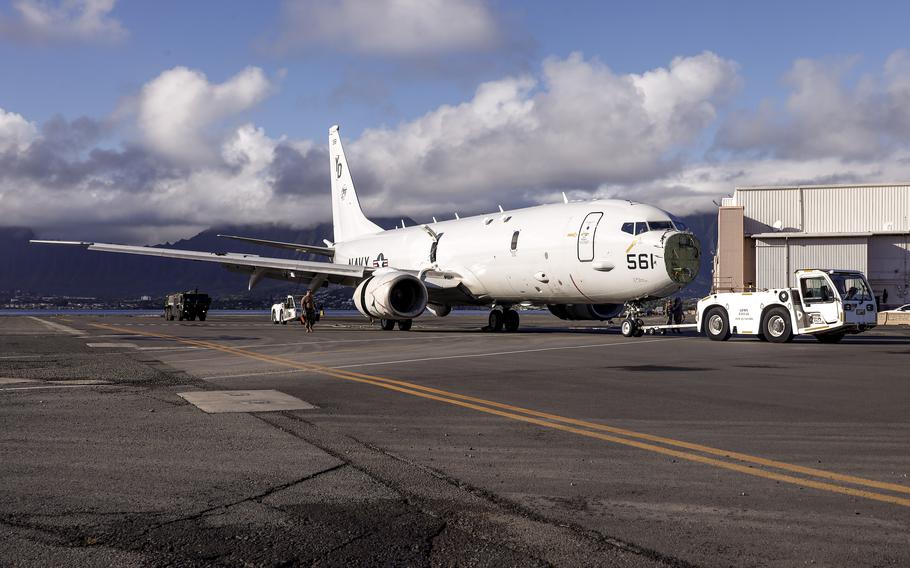
U.S. Navy Sailors tow a U.S. Navy P-8A Poseidon to a designated wash area after extraction from waters just off the runway at Marine Corps Air Station Kaneohe Bay, Marine Corps Base Hawaii, Dec. 4, 2023. The aircraft was relocated in preparation for decontamination of any potential foreign substances as well as salt water from its exterior. (Hunter Jones/U.S. Marine Corps)
(Tribune News Service) — Kim Fuller, an aquatic biologist with the state Department of Land and Natural Resources’ Division of Aquatic Resources, said department divers Tuesday will continue to assess the damage to the reef from a Navy P-8A Poseidon that slid off the runway at Marine Corps Base Hawaii.
State divers plan to continue surveying the damage to the coral reef around the base, where the front landing gear of the Navy plane “sort of pulverized the coral,“ and anchors from a boom installed to contain fuel leakage also left scars.
The recovery of the Navy P-8A Poseidon that slid off the base runway two weeks ago while trying to land in rainy weather was expected to cost $1.5 million. The plane ended up in water no deeper than 30 feet, and within 30 minutes Marines installed a boom around it.
But the installation of anchors to hold the boom in place also damaged the coral reef.
DLNR divers began assessing the damage Sunday after two days of work by the Navy, Marines and private contractors to use different-size roller bags to float the 60-ton warplane off the reef and tow it backward 100 feet and completely onto the base runway.
Dive teams inspected some 30 anchor points that were placed in coral to hold the booms in place, and said the majority of them were affecting coral.
Some of the damage left “small rubble pieces“ while other damage had “overturned“ coral, Fuller said Monday at a news conference at Marine Corps Base Hawaii. “You can see there is fresh, white breakage.”
She described the area beneath the plane as “sort of a silty bottom mixed with rubble, and there’s large coral colonies growing on top of that.”
Fuller said DLNR would like to take a week to do a more complete review, but said, “I would say we’ve seen the majority of the worst damage.”
DLNR divers Monday planned to return some of the larger broken coral pieces to their previous positions in the hope they will regrow, Fuller said. Others may have to be replaced using epoxy.
A federally “threatened“ green sea turtle was found dead between two of three booms Friday and had “a lot of tumors on the skin,“ said Navy Rear Adm. Kevin Lenox, who is in charge of the recovery of the P-8A.
“It did not appear to be a healthy turtle.”
As Navy officials worked last week to figure out how to best extract the plane from Kaneohe Bay, stormy weather caused the front landing gear stuck in a pocket of coral — along with the rest of the plane — to pivot about 30 degrees, leading to fears of further damage to the reef.
The plane’s left engine also came to rest on the reef.
P-8As stand at a height of 42 feet, and the doors of P-8A No. 516 were completely out of the water after it slid off the runway Nov. 20.
Using different-size roller bags, crews made “minute adjustments“ to methodically pull and roll it onto the runway and stabilize it as night fell Saturday, Lenox said. They had the plane fully on the runway Sunday.
Inspections found no damage to the plane’s sealed hydraulic fluid and oil systems, and all of the more than 2,000 gallons of fuel had already been extracted with no signs that ocean water had mixed with fuel — all suggesting that no contaminants leaked from the plane and into the bay, Lenox said.
He called the plane’s fuel and fluid systems “pristine. ... We’re very confident that no hazardous materials“ were released.
Inspectors found no damage to the plane’s landing gear, and the P-8A was expected to be cleaned of seawater Monday and eventually returned to duty. The Navy uses P-8As assigned to the “Skinny Dragons“ Patrol Squadron 4 out of Whidbey Island, Wash., for multiple missions including submarine warfare, intelligence, surveillance and reconnaissance.
The plane’s crew was attempting to land from the seaward end of the runway but ended up 100 feet off of the runway’s mountainside end.
Its presence in Kaneohe Bay caused fixed-wing aircraft operations to cease out of fear takeoffs and landings could also cause the P-8A to shift.
Col. Jeremy Beaven, commander of Marine Corps Base Hawaii, said Monday he will be flexible with flight operations to allow DLNR to do its work.
“I have a fair amount of latitude,“ Beaven said, “to support the time they need.”
He plans to give DLNR “adequate time so they don’t rush.”
A boom was already in place around the base to prevent contaminants from leaking into the bay. Beaven then ordered two more to be installed around the plane.
Beaven said he also ordered a boom around nearby Coconut Island, where the University of Hawaii’s Institute of Marine Biology conducts research on coral reefs and other marine life.
Because the P-8A showed no signs of leakage, Beaven called the boom around Coconut Island “preemptive in nature only.”
Military and civilian officials have been working “24 hours a day and Thanksgiving and weekends ... unrelenting over the last 14 days,“ Beaven said.
Before the recovery operation began Saturday morning, Lenox said Louisiana-based Center Lift used similar procedures to retrieve a much heavier, 1,000-ton barge that ended up in “sensitive sea grass“ after Hurricane Florence hit the Carolinas in 2018.
But on Monday he disclosed that the roller bag technique had been used for the first time to pull a plane back onto a runway.
“It was a successful weekend,“ Lenox said.
(c)2023 The Honolulu Star-Advertiser
Visit www.staradvertiser.com
Distributed by Tribune Content Agency, LLC.